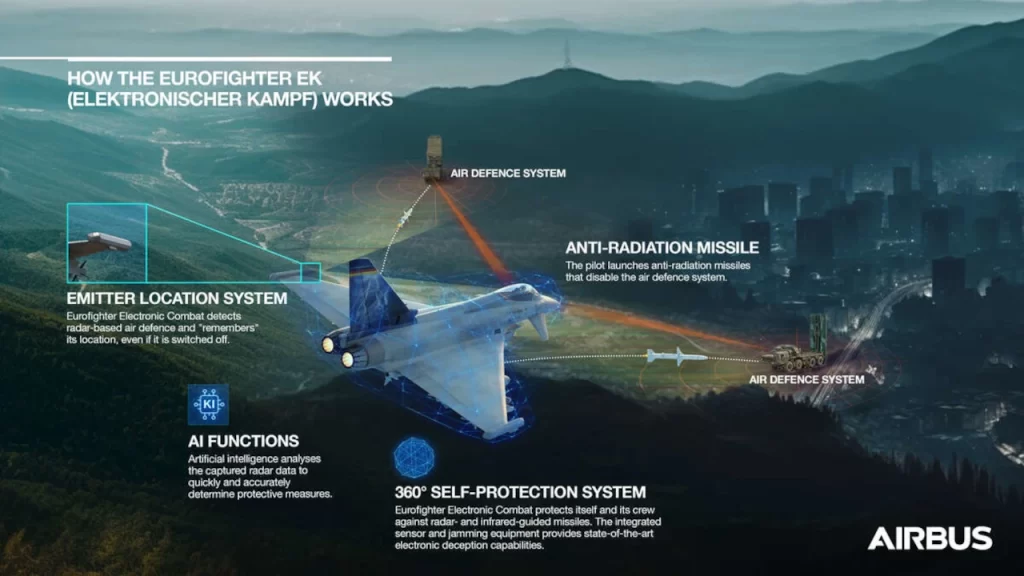Eurofighter Elektronischer Kampf (Electronic Combat, Eurofighter EK) will finally be a reality. Airbus will equip fifteen German Eurofighters for electronic combat, and they will be fitted with a transmitter location and self-protection system from Saab, as well as “AARGM” anti-radar missiles from the American company Northrop Grumman. This comes from the recent approval by the German budget committee in the German parliament. By 2030, the Eurofighter EK is scheduled to receive certification from NATO; at this point, it will take over the SEAD (Suppression of Enemy Air Defence) mission from the Luftwaffe’s Panavia Tornado.
In March 2022, the US announced the deployment of six Boeing EA-18g Growler fighter jets of the US Navy to Germany. Germany was contemplating whether to purchase Growler instead of Eurofighter EK then.
The recent wars and the current security situation demonstrate how crucial the two capabilities, Electronic warfare and reconnaissance, are for NATO, according to Michael Schollhorn, CEO of Airbus Defence and Space. He said the choice made by the German government to incorporate electronic warfare into the Eurofighter capabilities portfolio is particularly significant in this regard. According to him, EK will reinforce European sovereignty and autonomy while simultaneously adding this significant capacity to the already extensive operating spectrum of the Eurofighter.
The Eurofighter has been formally designated as the successor to the Tornado ECR (Electronic Combat/Reconnaissance) aircraft, as it has received approval from the Budget Committee of the Parliament parliamentary body. According to Airbus’s release, the company eagerly anticipates the official order to incorporate the chosen technical solutions into the Eurofighter. The contract between Eurofighter GmbH, as prime contractor, and NATO Eurofighter and Tornado Management Agency (NETMA) is anticipated to be signed before the year’s conclusion.

The Eurofighter EK will be able to detect, localise, and deactivate anti-aircraft radars thanks to the transmitter locating system developed by Saab and the Anti-Radiation Guided Missile (AARGM) developed by Northrop Grumman.
In May of 2023, Northrop Grumman Corporation announced that the AGM-88G Advanced Anti-Radiation Guided Missile Extended Range (AARGM-ER) programme of the United States Navy has accomplished its fifth consecutive flight test. Additionally, the missile could detect, identify, and engage a sophisticated emitter target located on land. It was the first time operations were carried out overland against operationally representative contemporary air defence system targets. This missile is currently being integrated into the F/A-18E/F Super Hornet and EA-18G Growler aircraft of the Navy, as well as the F-35A, F-35B, and F-35C aircraft of the US Air Force, Marine Corps, and Navy/Marine Corps respectively. Deliveries of AARGM-ER will commence later this year to support the US Navy’s initial operational capability in 2024.
Additionally, the Saab Arexis sensor suite solution includes jammers that enhance the Eurofighter’s ability to protect itself without assistance. Saab’s Arexis is a modular EW solution that employs smart software and high-tech modular components with a tiny footprint in a known and tested architecture. Saab characterises Arexis as a component that equips the Saab Gripen E/F fighter. SAAB claims that Arexis is made to fit every fighter aircraft. High-power gallium nitride (GaN) active electronically scanned arrays (AESAs) provide superior situational awareness in a complex signal environment, and state-of-the-art ultra-wideband receivers and digital radio frequency memories (DRFMs) provide unparalleled self-protection in all directions, according to Saab. Although the technology can be completely incorporated into an aircraft or a mission pod, how well it will fit into the Eurofighter EKs is not entirely apparent.
As a reminder, Airbus Germany initially proposed the EK version of the Typhoon in 2019, based on an aircraft carrying podded jammers, which was intended to achieve initial operating capability in 2028. Its purpose is to replace the Tornado ECRs that the Luftwaffe uses for defence suppression, although it cannot perform escort jamming.
Saab’s offer in June stated that the company would carry out a significant portion of the work in Bavaria, Germany, in collaboration with its partner Helsing, which specialises in artificial intelligence.
As per a statement made by Helsing in a previous press release, the company’s artificial intelligence platform analyses the radar data collected by the aircraft to produce precise self-protection measures against current adversary radars in milliseconds. According to Helsing, this new capability upgrade will also offer the basis for continuous iteration and development cycles. This will allow the EW suite to be updated at the same rate as software during the system lifecycle.
In addition, the Eurofighter EK incorporates technology created by start-ups, small and medium-sized businesses, and other types of businesses. One example is an artificial intelligence solution that permits the analysis of radar data onboard and the rapid determination of exact self-protection measures.
Airbus is presently collaborating with the procurement office of BAAINBw, the German Air Force, and the Bundeswehr Aviation Office to develop a comprehensive plan for implementing the chosen EK solutions in fifteen Eurofighters.
